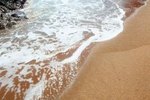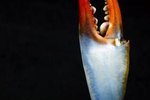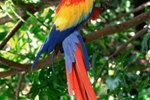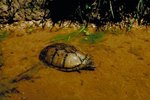
The Bahamas are home to many types of endangered species. Some choose to live on the islands only during the winter months, and others are born on the land. These endangered species below are key parts of the Caribbean ecosystem, and despite their dwindling numbers, are essential to the area.
Bahamian Rock Iguana
Three species of the Bahamian rock iguana (Cyclura cychlura, Cyclura carinata and Cyclura rileyi) and seven subspecies exist on the islands. All are protected by the Wild Animals Act, and the populations are listed as rare. The shrinking numbers of these creatures are attributed to natural disasters, human interference and the introduction of new predators such as cats and wild dogs. Growing to a length of between 2 and 3 feet, rock iguanas are usually brown. These large lizards feed on insects and plants as juveniles, but feed almost exclusively on vegetation as adults. They do not need to drink water as long as the plants they eat contain enough moisture. Preferring dry, sandy areas, the Bahamian rock iguana can live for up to 40 years.
West Indian Flamingo
The west Indian flamingo (Phoenicopterus ruber) is one of the rarest birds seen in the Bahamas. In the 1950s, it was thought they would become extinct, but the numbers have improved slightly since, reaching about 50,000. These birds are hunted for their feathers and meat, although it is illegal to catch or harm them in the Bahamas. The national bird of the Bahamas, this flamingo is a very strong flier, but prefers isolation. The largest Bahamian population is found in Inagua National Park, where many build their nests. Adult flamingos stand 4 feet tall, with a long neck and legs and bright pink feathers. They feed on food rich in carotene to keep their color bright. The food sources include brine shrimp, fly larvae, microscopic organisms, and small snails, which are strained upside down through their bills.
Bahamas Hutia
The Bahamas hutia (Geocapromys ingrahami) is a rodent native to the area. About the same size as a rabbit or guinea pig, these mammals weigh less than 2 pounds, and are varying shades of brown and gray. As a nocturnal creature, the hutia feeds on plants and twigs under the cover of darkness, and though they were at one time found on 10 Bahamian islands, the natural populations thrive only in East Plana Cay currently. This area is considered desert-like, offering prime conditions for breeding and living. In history, humans as well as other wild animals used the hutia as a food source, causing their numbers to drop. Natural disasters also are cause for the endangered status.
White-Cheeked Pintail
The white-cheeked pintail, also called the "Bahama Duck" (Anas bahamensis bahamensi) is a unique and beautiful species. Mostly brown with black speckles, a white chest and tail and red on the bill and eyes, this duck feeds on plants and invertebrates. They have the ability to survive in both fresh and saltwater, but their nests are often disturbed, which led to a decrease in population. Their predators include other animals, humans and the loss of habitat created by natural means as well as human expansion. In 2012, large numbers of these ducks washed up dead on the shore near the Baha Mar Development, after a large construction project started in the area.
Piping Plover
Although not indigenous to the Bahamas, the piping plover (Charadrius melodus) spends the winter months spread across the country. Fewer than 9,000 of this species exist in the world, and more than 1,000 fly to the Caribbean each winter. These small birds are not more than 7 inches in length, and have a tan upper body with a white belly. When breeding, a black band appears on the face, as well as on the breast and the legs turn a bright orange, but these colors fade during the rest of the year. Though the Bahamas seem to be a safe haven for the birds throughout the colder months of the year, what happens when they return to their regular habitats is what will either make or break the survival of this species.
Endangered Turtles
Two of the most critically endangered turtle species in the Bahamas are the loggerhead (Caretta caretta) and hawksbill (Eretmochelys imbricata). Each of these turtles has been hunted to the point of endangerment, but thrive in the conditions that the Bahamian waters present. Often said to be the most beautiful sea turtle, the hawksbill has a dark brown, black and yellow top shell, while their underside is yellow. Their full size is just about 3 feet and 100 pounds, and they grow by feeding on their favorite foods: sponges, sea urchins, small fish and plants. Their habitats are destroyed by the death of coral reefs both naturally and commercially, and their numbers drop due to hunting by humans. The loggerhead turtle can weigh almost 250 pounds at maturity, and grow to be more than 3.5 feet long. They feed on mainly meat, eating small fish, mollusks, jellyfish and crabs. The tops of their shells and brownish red, and shaped like hearts. Both the turtle meat itself and the eggs are prized by poachers, making them targets for hunting.
References
- Bahamas National Trust: Bahamian Rock Iguana
- Bahamas National Trust: West Indian Flamingo
- Bahamas National Trust: The Bahamian Hutia
- Repeating Islands: Bahamas Hutia
- Bahamas National Trust: White-Cheeked Pintail
- Bahamas Press: Bahama Ducks showing up dead
- Tribune 242: Endangered Bird Uses the Bahamas as a Winter Home
- US Fish and Wildlife Service: All About Piping Plovers
- Bahamas National Trust: Hawksbill Turtle
- Bahamas National Trust: Loggerhead Turtle
Photo Credits
-
Comstock/Comstock/Getty Images




